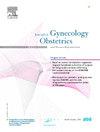第二次宫颈成熟手术是否能改善宫颈不佳的初产妇的阴道分娩结果?一项前后对比的法语研究。
IF 1.6
4区 医学
Q3 OBSTETRICS & GYNECOLOGY
Journal of gynecology obstetrics and human reproduction
Pub Date : 2025-08-11
DOI:10.1016/j.jogoh.2025.103008
引用次数: 0
摘要
目的:评价第二次宫颈成熟手术对宫颈发育不佳的初产妇的疗效。方法:于2018年1月1日至2022年8月15日在法国鲁昂大学医院进行回顾性、前后比较研究。纳入标准为有引产指征的头位单胎足月妊娠且有Bishop评分的妇女。结果:共有384名妇女纳入研究,然后分为方案前组(n=184)和方案后组(n=200)。方案后组剖宫产率显著降低(31% vs 40.8%;p = 0.04)。方案后组给予催产素前的Bishop评分显著高于方案后组(中位数:6 vs. 5;p = 0.01)。调整后,使用新方案与剖宫产风险之间无显著关联(OR 0.82;95% ci[0.58-1.34])。与剖宫产相关的独立因素有高龄产妇、非法国出生的妇女以及宫颈成熟前后Bishop评分较低。在宫颈持续不良的妇女亚组中,第二种手术改善了Bishop评分,但与剖宫产率的显著降低无关。结论:对持续低Bishop评分的妇女进行第二次宫颈成熟手术与降低剖宫产率没有显著相关。需要进一步的研究来评估联合宫颈成熟方法是否可以提高阴道分娩率。本文章由计算机程序翻译,如有差异,请以英文原文为准。
Does a second cervical ripening procedure improve vaginal delivery outcomes in primiparous women with an unfavourable Cervix? A before-and-after French study
Objective
To evaluate the effectiveness of a second cervical ripening procedure in primiparous women with an unfavourable persistent cervix.
Methods
This retrospective, before-and-after, comparative study was conducted at Rouen University Hospital, France between January 1st, 2018, and August 15th, 2022. Inclusion criteria were women with indications for labour induction with singleton term pregnancies in cephalic presentation and with a Bishop score <6 who required an initial cervical ripening. All women underwent an initial cervical ripening procedure with either a balloon catheter or vaginal dinoprostone. In the before-protocol group, labour induction was mostly pursued with oxytocin regardless of cervical status. In the after-protocol group (post-November 2020), a second cervical ripening procedure was proposed if the Bishop score remained ≤ 4. The primary outcome was caesarean section rate. A sensitivity analysis was also performed in women with a Bishop score <6 after the first ripening.
Results
A total of 384 women were included in the study and were then divided in the before- protocol group (n=184) or in the after-protocol group (n=200). The caesarean section rate significantly decreased in the after-protocol group (31 % vs. 40.8 %; p=0.04). Bishop scores before oxytocin administration were significantly higher in the after-protocol group (median: 6 vs. 5; p=0.01). After adjustment, no significant association was found between the use of the new protocol and the caesarean section risk (OR 0.82; 95 % CI [0.58–1.34]). Factors independently associated with caesarean delivery were advanced maternal age, women not born in France, and lower Bishop scores both before and after cervical ripening. In the subgroup of women with persistent unfavourable cervix, the second procedure improved Bishop scores but was not associated with a significant reduction in caesarean section rate.
Conclusion
A second cervical ripening procedure for women with persistent low Bishop scores was not significantly associated with reduced caesarean section rates. Further studies are needed to evaluate whether combining cervical ripening methods can enhance vaginal delivery rates.
求助全文
通过发布文献求助,成功后即可免费获取论文全文。
去求助
来源期刊

Journal of gynecology obstetrics and human reproduction
Medicine-Obstetrics and Gynecology
CiteScore
3.70
自引率
5.30%
发文量
210
审稿时长
31 days
期刊介绍:
Formerly known as Journal de Gynécologie Obstétrique et Biologie de la Reproduction, Journal of Gynecology Obstetrics and Human Reproduction is the official Academic publication of the French College of Obstetricians and Gynecologists (Collège National des Gynécologues et Obstétriciens Français / CNGOF).
J Gynecol Obstet Hum Reprod publishes monthly, in English, research papers and techniques in the fields of Gynecology, Obstetrics, Neonatology and Human Reproduction: (guest) editorials, original articles, reviews, updates, technical notes, case reports, letters to the editor and guidelines.
Original works include clinical or laboratory investigations and clinical or equipment reports. Reviews include narrative reviews, systematic reviews and meta-analyses.
 求助内容:
求助内容: 应助结果提醒方式:
应助结果提醒方式:


